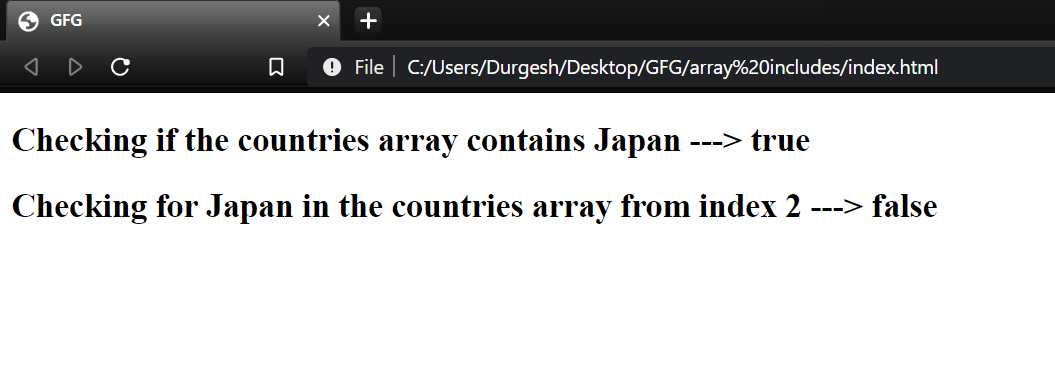JavaScript 如何使用包含对象的数组并根据对象的属性进行检查
Array.includes()
方法: 在JavaScript中,includes()方法用于确定数组中是否存在特定元素。如果该元素存在,它将返回 true ,如果不存在,则返回 false 。
语法:
array_name.includes(searchElement, ?fromIndex)
参数:
- searchElement: 要在数组中搜索的元素。
- fromIndex: 要从中搜索元素的索引。这是一个可选参数。
示例:
HTML
<!DOCTYPE html>
<html lang="en">
<body>
<h2>
Checking if the countries
array contains Japan --->
<span id="ans"></span>
</h2>
<h2>
Checking for Japan in the countries
array from index 2 --->
<span id="ans2"></span>
</h2>
<script>
let countries = ["India", "Japan",
"Canada", "Germany", "Australia"];
// 1st Output
let ans = document.querySelector("#ans");
let output = countries.includes("Japan");
ans.append(output);
// 2nd Output
let ans2 = document.querySelector("#ans2");
let output2 = countries.includes("Japan", 2);
ans2.append(output2);
</script>
</body>
</html>
输出:

1. 使用 in 运算符 : 如果属性存在于对象中,则返回true,如果不存在则返回false。它检查对象的自身属性和继承属性。
语法:
'property_name' in object_name
示例:
JavaScript
<script>
let Person = {
name: "durgesh",
age: 16
}
// Output: true
console.log('name' in Person)
// Returns true for an inherited
// property
// Output: true
console.log('toString' in Person)
// Output: false
console.log('gender' in Person)
</script>
输出:
true
true
false
注意: 上面示例中使用的toString()方法是从原型对象继承的属性。’in’ 运算符返回原型继承的属性的值为true。
使用hasOwnProperty() 方法: 如果属性存在于对象中,则返回true;如果不存在,则返回false。它仅检查“ 自有”属性(即在对象内部定义的属性)。
语法:
object_name.hasOwnProperty('property_name')
示例:
Javascript
<script>
let Person = {
name: 'Durgesh',
age: 16
};
// Output: true
console.log(Person.hasOwnProperty('name'))
/* hasOwnProperty() doesn't checks for
inherited properties of the object. */
/* toString() is an inherited property. */
// Output: false
console.log(Person.hasOwnProperty('toString'));
// Output: false
console.log(Person.hasOwnProperty('gender'));
</script>
输出:
true
false
false
与undefined比较:
评估对象中不存在的属性会返回undefined。因此,我们可以将结果与undefined进行比较,以确定属性是否存在或缺失。
示例:
Javascript
let Person = {
name: 'Durgesh',
age: 16
};
// Returns true if the property is present
// Output: true
console.log(Person.name !== undefined)
// Returns true for inherited property
// Output: true
console.log(Person.toString !== undefined)
// Output: false
console.log(Person.gender !== undefined)
输出:
true
true
false
注意: 与上述两种方法相比,这种方法并不好,因为 如果对象中的属性被定义为undefined,则该方法会将其评估为false。 如果您的对象的属性值可能为undefined,建议使用上述两种方法。
Javascript
let Person = {
// Setting name to undefined
name: undefined,
age: 16
};
/* This evaluates to false despite
the fact that name property exists */
// Output: false
console.log(Person.name!==undefined)
输出结果:
false
 极客教程
极客教程